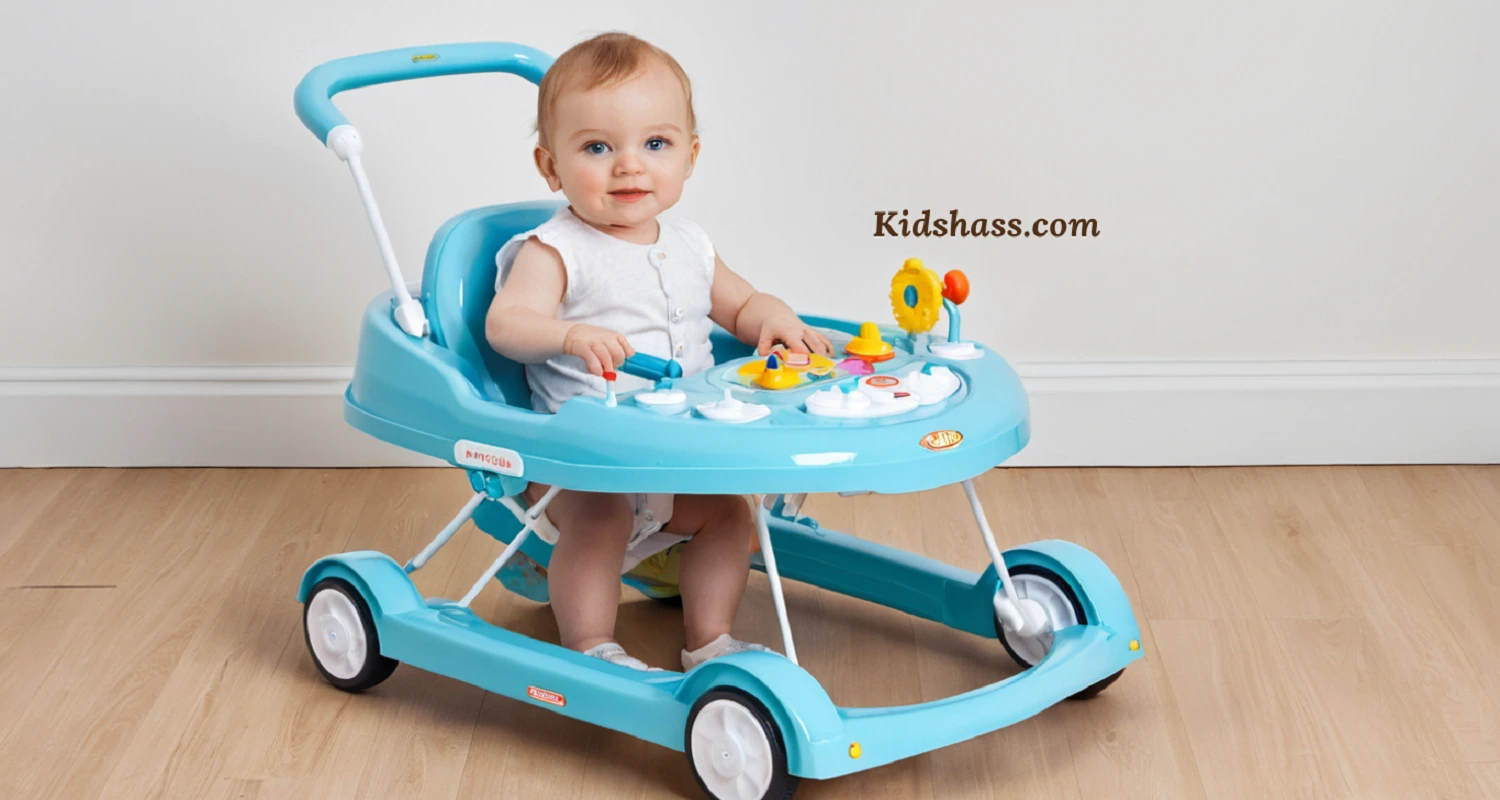Introduction
As your baby begins to show interest in walking, many parents consider tools to aid their development. One common option is the baby push walker, which helps babies gain mobility while providing some level of support. However, parents often wonder: “Are baby push walkers safe?” This article will explore safety concerns, benefits, and expert tips for using baby push walkers effectively, while also addressing key safety guidelines recommended by trusted organizations in child health and development.
1. What Is a Baby Push Walker?
A baby push walker is a mobility tool designed for infants learning to walk. Unlike traditional seated walkers, push walkers require the baby to remain upright, holding onto a handle and pushing the walker forward. This encourages early movement and balance.
1.1. Types of Baby Push Walkers
There are two common types of push walkers:
- Plastic Walkers: Lightweight and often featuring interactive toys or music.
- Wooden Walkers: Heavier and more stable, providing strong support for babies learning to walk.
Both types aim to foster early walking, though parents should be mindful of their child’s readiness and ability to use the walker safely.
For more detailed information on other types of walkers, you can also read our related article: Are Baby Walkers Safe? Understanding the Risks and Exploring Safer Alternatives.
2. Are Baby Push Walkers Safe?
Safety is a major consideration for parents thinking about baby push walkers. Although they offer several benefits, there are associated risks.
2.1. Safety Concerns
Parents should be aware of the following potential dangers:
- Risk of Falls: Push walkers can sometimes move too quickly on slippery surfaces, increasing the risk of falls.
- Stair Hazards: Unsupervised use near stairs can result in accidents, so it’s important to block off staircases.
- Unintended Access: Babies in push walkers can quickly move toward dangerous areas, such as sharp objects or hot surfaces.
Studies have raised concerns about these risks, particularly with traditional baby walkers. Institutions like the American Academy of Pediatrics (AAP) recommend parents carefully assess any product that could lead to injuries. AAP’s guidelines emphasize the importance of limiting access to unsafe areas and maintaining constant supervision.
2.2. Alternatives and Safer Practices
Parents can turn to safer alternatives, such as stationary activity centers or hand-held walking aids, which promote motor skills without the risks of mobility tools. Resources from pediatric professionals provide further recommendations on how to encourage walking without the dangers posed by walkers.
3. Benefits of Baby Push Walkers
Despite concerns, there are several benefits when baby push walkers are used under supervision and within a controlled environment.
3.1. Encourages Independent Movement
Push walkers offer babies the opportunity to move freely and develop coordination at their own pace. Babies feel empowered to explore their surroundings while maintaining control of their movement.
3.2. Motor Skill Development
The act of pushing the walker improves gross motor skills, strengthening muscles in the arms, legs, and core. Babies learn to balance themselves and distribute weight more effectively.
3.3. Builds Confidence
As babies become more familiar with movement, they gain confidence in their walking ability. Early mobility tools, like push walkers, can help bridge the gap between crawling and walking independently.
4. How to Choose a Safe Baby Push Walker
Selecting a safe push walker is crucial to minimizing the risks and maximizing benefits. Here are key features to look for:
4.1. Stability and Weight
Heavier walkers with wide bases tend to be more stable, which prevents tipping. Wooden push walkers generally provide better balance than plastic alternatives, though each product should meet safety standards.
4.2. Adjustable Speed
Walkers that offer adjustable speed controls help prevent them from moving too quickly, especially on slick surfaces like hardwood floors. Controlling the pace allows for safer movement as your baby gains balance.
4.3. Non-Slip Wheels
Look for push walkers with wheels that provide good traction. Non-slip or rubberized wheels help reduce the likelihood of falls, especially on smooth surfaces.
4.4. Safe Materials
Ensure that the walker is made from non-toxic, baby-safe materials. Any small, detachable parts or sharp edges should be avoided, as they can pose choking or injury hazards.
To confirm the product you choose meets industry safety standards, consult regulatory bodies that offer product safety certifications and guidelines.
For safety standards and product guidelines, check the Consumer Product Safety Commission (CPSC) website to ensure the product meets the necessary safety regulations.
5. Best Practices for Safe Use of Baby Push Walkers
Even with a safe walker, proper usage is key. Here are important tips to keep your baby safe:
5.1. Always Supervise
Never leave your baby unattended while using a push walker. Constant supervision helps prevent accidents, particularly around stairs and furniture.
5.2. Use in a Baby-Proofed Environment
Ensure the walker is used in a child-proofed space free of hazards. Block off access to stairs, sharp objects, or unstable furniture that could tip over.
5.3. Limit Usage Time
Prolonged use of push walkers can place stress on your baby’s developing legs and feet. Short sessions of 10–15 minutes are ideal, allowing babies to build muscle while reducing strain.
5.4. Encourage Independent Walking
While push walkers can aid development, make sure to balance their use with opportunities for your baby to walk without assistance. Independent movement helps strengthen muscles and improve coordination.
For expert guidance on promoting safe walking habits, consult recognized organizations in child development.
6. Alternatives to Baby Push Walkers
If you’re concerned about the risks, consider these safer alternatives:
6.1. Push Toys
Simple push toys like shopping carts or toy lawnmowers allow babies to practice walking while offering support without the added mobility risks of push walkers.
6.2. Hand-Held Walking
Holding your baby’s hands while they walk is a great way to help them gain confidence and build balance without the need for equipment.
6.3. Activity Centers
Stationary activity centers provide a way for babies to stand and engage with toys, strengthening their leg muscles in a safer, controlled environment.
These options provide a balance of support and safety, allowing babies to develop walking skills with less risk.
FAQs About Baby Push Walkers
Q: Are baby push walkers safe?
A: When used correctly, baby push walkers can be safe, but they still present risks. Expert recommendations suggest careful supervision and usage in a safe environment.
Q: What age is suitable for baby push walkers?
A: Babies can begin using push walkers around 9 to 12 months, depending on their physical development and ability to stand.
Q: Can baby push walkers delay walking?
A: Over-reliance on push walkers can slow down independent walking development. It’s important to give babies opportunities to walk without assistance.
Q: How long should my baby use a push walker each day?
A: Limit walker sessions to 10–15 minutes at a time to avoid overexerting your baby’s legs and feet.
Conclusion
While baby push walkers can be beneficial tools for early mobility, parents must be mindful of the risks. Selecting a stable, well-designed walker and following safety guidelines is essential to prevent injuries. Parents are encouraged to explore alternative methods of promoting walking that are less prone to risks. For a deeper understanding of baby walker safety and recommendations from child development experts, refer to trusted sources that provide in-depth information on this topic.


This was such an insightful post! I had no idea there were so many factors to consider when choosing a baby walker. Do you have any recommendations for walkers that work well on carpeted floors? My little one loves scooting around, but our rugs make it tricky!